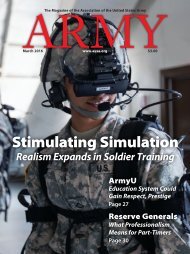Army - Kicking Tires On Jltv
Create successful ePaper yourself
Turn your PDF publications into a flip-book with our unique Google optimized e-Paper software.
Historically Speaking<br />
Verdun at 100 By Brig. Gen. John S. Brown, U.S. <strong>Army</strong> retired<br />
Feb. 21 marks the 100th anniversary of the German assault<br />
on Verdun, France. It launched the savage, 10-month<br />
World War I battle that has become a metaphor for bloodshed<br />
and indecisiveness. Soldiers on both sides endured incredible<br />
hardships, providing their generation a vision of hell on Earth.<br />
It was an experience no army wanted to repeat, fueling ardent<br />
searches for ways to break the deadlock on the Western Front<br />
other than by the means employed in this battle.<br />
Our own <strong>Army</strong> became a benefactor of the resultant doctrinal<br />
ferment. Our generations-long emphasis on decisive maneuver<br />
warfare stands in stark contrast to the brutal attrition<br />
the fighting for Verdun became.<br />
In early 1916, Gen. Erich von Falkenhayn, chief of the<br />
German General Staff, faced a two-front war: in Russia and<br />
on the Western Front. This had ground on for a year and a<br />
half, with huge losses and no decision. Falkenhayn recognized<br />
that Germany did not have the resources to conquer and occupy<br />
either Russia or France while heavily engaged with the<br />
other. He believed an attack on Verdun, surrounded on three<br />
sides by the Germans and psychologically and physically vital<br />
to the defense of France, would draw the French army into a<br />
battle wherein it could be “bled white.”<br />
Artillery fire had proven to be far and away the greatest killer<br />
in World War I, and observed artillery fire was far more effective<br />
than unobserved. A massive yet tightly controlled offensive<br />
could quickly seize the high ground surrounding Verdun, giving<br />
the Germans fields of view the French would lack. The<br />
French would be forced to counterattack or to endure unrelenting<br />
exposure to devastating observed artillery fire. French return<br />
fire would be largely unobserved and thus, far less effective.<br />
French counterattacks in the face of entrenched defenders,<br />
machine guns and artillery would inevitably be costly.<br />
The German Fifth <strong>Army</strong> assumed the mission of attacking<br />
Verdun, and gathered over a million men and 1,200 guns to<br />
do so. Of the guns, two-thirds were heavy. The Germans built<br />
10 new rail spurs off their main line running just 15 miles<br />
north of Verdun, and scheduled about 33 munitions trains per<br />
day. They stockpiled enough artillery ammunition to fire 2<br />
million rounds in the first six days, and another 2 million<br />
rounds in the next 12.<br />
The Germans planned on swarming in aircraft sufficient to<br />
deny the French use of the air, depriving them of this other<br />
potential source for observed artillery fire. The French had<br />
stripped Verdun’s defenses of artillery to meet needs elsewhere.<br />
However, alerted by their intelligence services at the<br />
11th hour, the French rushed in artillery reinforcements sufficient<br />
to give them 388 field guns and 244 heavy guns prior to<br />
the German attack.<br />
The German attack, preceded by a 12-hour bombardment,<br />
U.S. soldiers line the trenches near Verdun, France.<br />
advanced methodically and well during the first several days. It<br />
penetrated the first and second trench lines in the attack zone.<br />
The weight of the German attack was to the east of the Marne<br />
River and here, they seized the key terrain of Fort Douaumont<br />
by Feb. 25. This was about 4 miles from their start point. A<br />
day later, the attack began to sputter. Snow, a thaw, ground<br />
pulverized by artillery, and heavy traffic combined to turn the<br />
terrain it was moving through into a muddy morass.<br />
German artillery, in particular, had difficulty moving, soon<br />
finding itself out of range of critical targets. French reinforcements<br />
rushed in. Some French generals, under pressure, recommended<br />
withdrawing from the east bank of the Meuse<br />
River. Gen. Joseph J. Joffre, the French commander in chief,<br />
promised to court-martial any general who retreated. He appointed<br />
Gen. Philippe Petain to direct the defense. The<br />
ragged and sawtooth French lines held.<br />
Most notably, the French held on to enough of the high<br />
ground east of the Meuse to see into the German rear. They<br />
brought masses of observed artillery fire onto the Germans,<br />
even as the Germans were bringing masses of observed artillery<br />
fire onto them. Losses on both sides mounted. The<br />
Germans ascertained that the French artillery was concentrated<br />
on the high ground west of the Meuse, and resolved to<br />
broaden their attack to the west to neutralize this threat.<br />
A renewed attack beginning March 6 made some progress,<br />
but not enough to seriously degrade the French artillery. By<br />
April 9, the Germans had advanced perhaps 3 miles along the<br />
west bank of the Meuse. They advanced in the east as well and<br />
seized Vaux, but the French still held on to critical perches<br />
east of the Meuse. The Germans had reached within 5 miles<br />
of Verdun itself, but seemed to have forgotten that Verdun<br />
was supposed to be bait rather than an objective in itself.<br />
Library of Congress<br />
February 2016 ■ ARMY 63

















